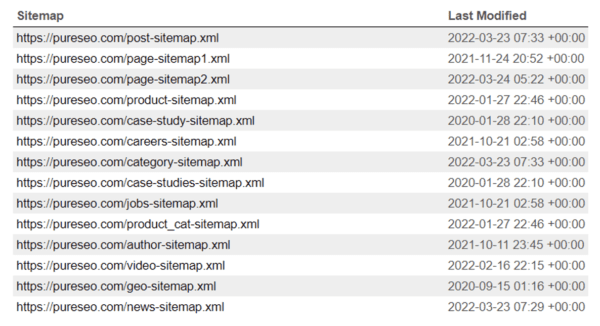The Pure SEO Team
The editorial team at Pure SEO is super proud of our content. Follow our official channels on social media.

What are sitemaps and why are they important for SEO? The experts at Pure SEO have put together a guide to XML and HTML sitemaps, providing everything you need to know to get started. Read this ultimate guide below to learn everything about XML and HTML sitemaps and SEO best practices.
A sitemap is a tool that makes your website easier to navigate for search engines and people. Sitemaps let search engines explore your site efficiently, offering clues to search engine crawlers (i.e., spiders and bots), so they can find, crawl, and index your website’s content. This, in turn, helps them accurately represent your site in search rankings.
There are two types of sitemaps to be aware of: XML sitemaps and HTML sitemaps. Both are beneficial for websites. XML sitemaps are made to help search engines find and prioritise pages on your website. HTML sitemaps are made to help visitors find relevant pages on your website.
Below, we explore the differences between these two sitemaps.

An XML sitemap is a complete list of a website’s URLs. These can help search engines and spiders discover crawlable pages on your website. In general, web crawlers discover pages through internal links from the website and external links from other sites—with or without a sitemap.
A sitemap doesn’t guarantee that a site’s pages will all be indexed by search engines, but it does help crawlers navigate your site more easily and helps to inform them of which pages to prioritise.
XML sitemaps are particularly useful for large websites with many landing pages (e.g., e-commerce websites), that might otherwise take spiders a long time to explore. This is because every site has a ‘crawl budget’, and search engines are unlikely to crawl every URL they encounter the first time. An XML sitemap can help search engines build a queue of pages to serve.
Without a sitemap, search engines would need to crawl every page before they can build a full menu of all URLs within a site. However, with a sitemap, search engines can simply know what pages exist without crawling every page.
A sitemap in its simplest form is an XML file with a complete list of a website’s URLs as well as metadata about each URL. Metadata helps search engines crawl a site more intelligently and can include information about a page such as when it was last updated, how frequently it changes, and how important the URL is in comparison to other pages on the website. However, there are other types of sitemaps to consider, for example:
You may need an XML sitemap if:
While these are general guidelines, every single website can benefit from a sitemap, as websites need Google to find their most priority pages easily and to know when they are updated.
Your XML sitemap should include any page on your website that you want visitors to land on, primarily those that elicit conversions and engagement. The pages most essential for your XML sitemap are:
Sitemaps for media are a good SEO practice. A separate sitemap may be appropriate for images, which can help search engines discover images they may otherwise have overlooked.
HTML sitemaps contain every page a website has—from the main priority pages to the lower-level pages. Fundamentally, HTML sitemaps are just a clickable list of pages on a website that exist to serve website visitors. They can be considered a well-thought-out table of content. For users who can’t find the content they’re looking for—especially on websites with confusing layouts—an HTML sitemap can be a useful directory to help them get to where they want to go.
While you may already use an XML sitemap, you may wonder about the necessity of HTML sitemaps. There are several reasons why you should keep or add an updated HTML sitemap to your repertoire, including the following:
There are multiple ways that sitemaps affect SEO on your website. For example, by incorporating keywords in your sitemap, you can help search engines like Google, Yahoo, and Bing find different pages on your site. Sitemaps can also:
An HTML sitemap is content-based and can be used to highlight a website’s purpose to both visitors and search engines. By incorporating unique and relevant keywords into your sitemap anchor text, you can promote keyword relevancy for specific pages on your site. Anchor text in a sitemap can also be useful for pages that don’t have many cross-links.
Sitemaps speed up the work of search engine bots crawling your site. It helps them find your content and prioritise it on the crawl queue. While XML sitemaps just offer a list of links, search crawlers prefer the format of HTML links when exploring the web. HTML sitemaps help spotlight your important content and pages, and the text version of your sitemaps can be submitted to Google.
By facilitating easy navigation, a sitemap can help spiders better understand a website’s taxonomy. Crawlers exploring your site may pass over pages in favour of other ones; for example, search bots may choose to follow a link on one page to verify that the link makes sense. In doing so, they may never return to continue indexing the pages left unindexed. By facilitating easy navigation, an HTML sitemap can help bots get the entire picture of your website more efficiently.
HTML sitemaps can help identify areas on a site where navigation could be improved. Mapping out all the pages available minimises the chance of duplicate data, and helps you find any that already exists.
Your first step is to craft your sitemap. If you use WordPress, you can use the Yoast SEO plugin to make a sitemap for you. A benefit to Yoast is that it updates your XML sitemap automatically when you add new pages. However, for those who don’t use Yoast, for are a range of other plugins available for WordPress sites that can help you create a sitemap. For websites that don’t use WordPress—no worries! There are still plenty of third-party XML sitemap generator tools to use.
Once your sitemap is created, you should review it to make sure it displays all the pages on your site. If everything looks right, you can submit your sitemap to Google by logging in to your Google Search Console account:
If you use WordPress, there are many sitemap plug-ins available to help you create an HTML sitemap. Like with XML sitemaps, plug-ins for HTML sitemaps automate most of the sitemap development and management process.
For large websites, you might need to run a web crawl like Screaming Frog or SiteBulb (both on desktop), or OnCrawl or DeepCrawl (in the cloud). The outputs of this web crawl should serve as the foundation for organising a site’s pages around themes.
After the HTML sitemap is created, make sure to put a link to it on your website for visitors to easily find. Choose somewhere that will continue to be accessible to users as they click through your website, such as the sidebar at the top, or in a footer menu.

